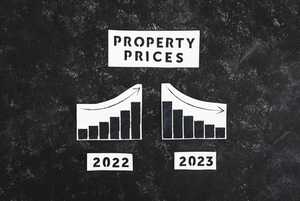House prices continue to fall

UK house prices declined for the third month in a row in June, according to the latest monthly report from the Halifax.
A typical property now costs £285,932. This is down by around £300 or 0.1% compared to May and a drop of £7,500 or 2.6% on an annual basis -- the largest year-on-year decrease since June 2011.
And a new report suggests that we could see further significant falls in property prices.
Squeeze on affordability
The rate of decline in June largely reflected the impact of historically high house prices last summer, when the market was boosted by a temporary cut in Stamp Duty, explained Kim Kinnaird, Halifax's director of mortgages. Annual growth peaked at 12.5% in June 2022.
Kinnaird noted that the volume of mortgage applications held up well throughout June this year, particularly from first-time buyers. However, the market remains sensitive to volatility in borrowing costs.
"Concerns about persistent inflation have led to a significant increase in the cost of funding," Kinnaird added. "Coupled with base rate rising by another 50bp, this contributed to a big jump in typical mortgage rates over the last month.
"The resulting squeeze on affordability will inevitably act as a brake on demand, as buyers consider what they can realistically afford to offer."
With the base rate now anticipated to peak at over 6%, mortgage rates are likely to remain higher for longer, and the squeeze on household finances will continue to put downward pressure on house prices over the coming year.
Longer-term gain for young people
If interest rates remain persistently high, the house to price earnings ratio could drop from its peak of 8.9 last year to 5.6, a level not seen since the turn of the century, according to the Resolution Foundation.
A report by the think tank in partnership with the abrdn Financial Fairness Trust says that this could mean house price falls of as much as 25% in cash terms over five years.
The authors highlighted two ways in which falling house prices could make it easier for younger generations to get on the property ladder:
"First, it will reduce the deposit barrier for first-time buyers. Back in the mid-1990s, it would have taken a typical young, first-time buyer couple around eight years to save for a 10% deposit on an average first-time home. This figure has risen to 14 years today, but could fall back to around ten years in this lower-wealth scenario.
"Second, while rising rates add to the cost of repaying mortgages, this would be more than offset by the lower mortgage principal needed to purchase the house, thus reducing the overall lifetime cost of property ownership for new buyers."
Mubin Haq, CEO of abrdn Financial Fairness Trust, added: "The short-term pain of higher interest rates for mortgage holders could also mean a longer-term gain for young people hoping to buy their own homes and saving for their pensions. Both become more affordable and allow for a fairer sharing of wealth. In these turbulent times, when assets have tended to held by older generations, we may see rising interest rates reversing the growth in wealth gaps Britain has seen over recent decades."
Posted by Fidelius on July 17th 2023

